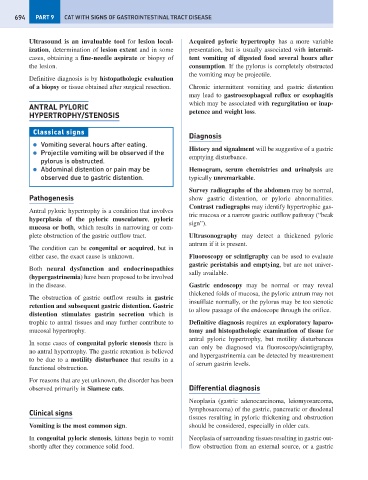Page 702 - Problem-Based Feline Medicine
P. 702
694 PART 9 CAT WITH SIGNS OF GASTROINTESTINAL TRACT DISEASE
Ultrasound is an invaluable tool for lesion local- Acquired pyloric hypertrophy has a more variable
ization, determination of lesion extent and in some presentation, but is usually associated with intermit-
cases, obtaining a fine-needle aspirate or biopsy of tent vomiting of digested food several hours after
the lesion. consumption. If the pylorus is completely obstructed
the vomiting may be projectile.
Definitive diagnosis is by histopathologic evaluation
of a biopsy or tissue obtained after surgical resection. Chronic intermittent vomiting and gastric distention
may lead to gastroesophageal reflux or esophagitis
which may be associated with regurgitation or inap-
ANTRAL PYLORIC
HYPERTROPHY/STENOSIS petence and weight loss.
Classical signs
Diagnosis
● Vomiting several hours after eating.
History and signalment will be suggestive of a gastric
● Projectile vomiting will be observed if the
emptying disturbance.
pylorus is obstructed.
● Abdominal distention or pain may be Hemogram, serum chemistries and urinalysis are
observed due to gastric distention. typically unremarkable.
Survey radiographs of the abdomen may be normal,
Pathogenesis show gastric distention, or pyloric abnormalities.
Contrast radiographs may identify hypertrophic gas-
Antral pyloric hypertrophy is a condition that involves
tric mucosa or a narrow gastric outflow pathway (“beak
hyperplasia of the pyloric musculature, pyloric
sign”).
mucosa or both, which results in narrowing or com-
plete obstruction of the gastric outflow tract. Ultrasonography may detect a thickened pyloric
antrum if it is present.
The condition can be congenital or acquired, but in
either case, the exact cause is unknown. Fluoroscopy or scintigraphy can be used to evaluate
gastric peristalsis and emptying, but are not univer-
Both neural dysfunction and endocrinopathies
sally available.
(hypergastrinemia) have been proposed to be involved
in the disease. Gastric endoscopy may be normal or may reveal
thickened folds of mucosa, the pyloric antrum may not
The obstruction of gastric outflow results in gastric
insufflate normally, or the pylorus may be too stenotic
retention and subsequent gastric distention. Gastric
to allow passage of the endoscope through the orifice.
distention stimulates gastrin secretion which is
trophic to antral tissues and may further contribute to Definitive diagnosis requires an exploratory laparo-
mucosal hypertrophy. tomy and histopathologic examination of tissue for
antral pyloric hypertrophy, but motility disturbances
In some cases of congenital pyloric stenosis there is
can only be diagnosed via fluoroscopy/scintigraphy,
no antral hypertrophy. The gastric retention is believed
and hypergastrinemia can be detected by measurement
to be due to a motility disturbance that results in a
of serum gastrin levels.
functional obstruction.
For reasons that are yet unknown, the disorder has been
observed primarily in Siamese cats. Differential diagnosis
Neoplasia (gastric adenocarcinoma, leiomyosarcoma,
lymphosarcoma) of the gastric, pancreatic or duodenal
Clinical signs
tissues resulting in pyloric thickening and obstruction
Vomiting is the most common sign. should be considered, especially in older cats.
In congenital pyloric stenosis, kittens begin to vomit Neoplasia of surrounding tissues resulting in gastric out-
shortly after they commence solid food. flow obstruction from an external source, or a gastric

